C.I.S.E.I. Principle and Medium-Long Distance Running
This is a very old forum post I made in 2006 at CharlieFrancis.com forum. Why I am reposting it? First of all to pull out old stuff under layers of dust, and second to show the difference between utilizing common “aerobic zones” versus using the competitive performance as a prescriptive system.
As I always say, the higher the level of the athlete deeper down the rabbit hole one needs to go to find the limiters of performance and the best strategy how to overcome them. Speaking of that, utilizing “physiological zones” is a good starting point when combined with the following approach. But later more elaborate planning is needed taking into account athletic characteristics, race demands, and of course context/constraints.
Anyway, enjoy this old article of mine.
Introduction
During running over some distance there is a velocity (speed) plot similar to that in Fig 1. Off course this is oversimplification because there is no pacing strategies, oscillations etc. This is only basic form. Over that period there is mean velocity (V0) which is plotted in the graph (note that there is no oscillations, so V0 have this value).
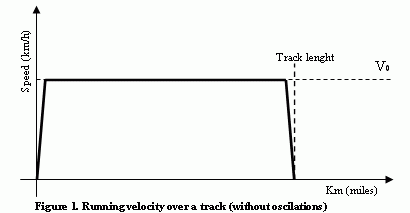
Training goal is in improving the time over the track length is covered, so basically you should improve you mean running SPEED. So goal of training is not on improving VO2max, LT, HR or other physiological variables but rather performance – mean speed (Fig. 2).
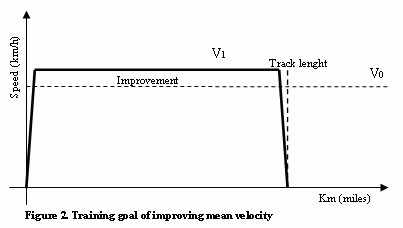
The question is how can we improve this mean speed? One common option is increasing your volume of training. You can do this by increase distance over which you run (with the same mean speed- Fig. 3) or by performing same runs (Fig.1) several times over a week. But can this induce improvement of mean running speed? NO! Maybe with beginners, who have great speed reserve (a term which I would discuss later in the text) and low muscle fatigue tolerance. Basically first step in training with beginners is to increase volume of training. That doesn’t mean that you should increase it to the max, but only to the optimum level. What is the optimum? That depends on the ability to adapt and recover, two thing that are highly genetically determined. When you reach the optimum level of volume, then keep it and try to improve mean running speed. How? You can use CISEI principle covered here.
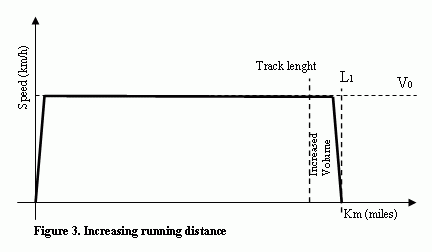
I think that we need to define what is endurance. Is that a ability to tolerate fatigue as commonly defined? Take an example. You have two marathon runners, runner A finish marathon in 2h30min and other, runner B in 3h00min. Who have more endurance? If this definition is used then runner B have more endurance because he is able to cope with the fatigue for a longer period of time. Maybe this is reason (erroneous off course) to increase volume of training to improve endurance. But endurance is the ability to maintain relative intensity over a prolonged period of time without serious drop in performance due fatigue. So basically, to improve endurance you gotta improve you speed, duration over which you can maintain that speed and ability to cope with the fatigue development (and fatigue when it is developed).
Cutting distance and Intensify the running speed
This is my point of view in improving mean running speed without increasing volume. I don’t believe that I “discovered it” but rather copied/steal it, because this is largely used in training (without using HR monitors, LA analyzers and other gadgets) but I think that people started to forget this simple principle.
What is this all about? Basically, if you cant improve your mean running speed over some distance, then Cut the distance and run it faster (Fig. 4.). You don’t need a HR monitor, just your performance variables: running times, distances and subjective feeling (I only approve using HR measurement in the morning and in recovery for measuring adaptive responses but not for designing training programs).
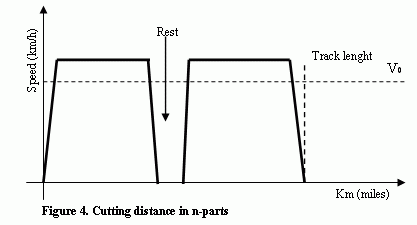
You can cut the distance in 2-3 parts and run it with higher speed. But how higher? You can use some percentage of your V0 (running time), but this should be calculated individually. Do not increase running speed too much too early. Give some time for your body to adapt! Experienced runner should cut the distance in more parts which can allow them to cover it in greater running speed. Why is that? Because their endurance is so high that their speed reserve is so low so they should concentrate on improving their max speed(even conducting 100m sprints). More on this later. Rest should be long enough to allow you to do all the reps without drop in performance. You can calculate rest on the basis of running time (percentage of time or distance if you walk or jog during rest). In picture rest is depicted as a walking distance. It is your creativity, I am just putting general principles here!
Shorten rests – Extend distance covered in one rep
After conducting several training sessions with split distance and higher speed, try to shorten the rests (less walking distance, or less time) and to extend the distance covered in one rep. This is also strongly individually based on the athlete’s ability to recover and to adapt. After doing this try to run you distance and you will see that your time has been improved (Integrate). On the other hand, I believe that if you continue to run continuously on steady-running speed your body will accommodate that running speed and then you will have problem changing it (increasing). So, improving your ability to run faster (over some distance – endurance) will not guarantee you that you will run at that speed… you should accommodate on new, improved speed and the only way to do it is to increase your training speed!
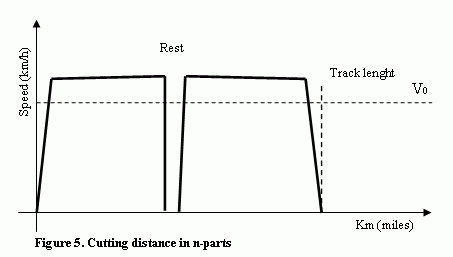
Example
Distance: 5K
Running time: 25min
Using CISEI (splitting in half)
Distance: 2.5K
Running time: 9 min (10% better)
Reps: 2x
Rest: ½ running time (4min)
Goals
1. Try to improve speed (shorter running time)
2. Decrease rest (less walking or jog distance or less time resting) or increase intensity of jog during rest
3. Extend distance (from 2.5K to 3K)
4. Try to run 5K in improved speed
Note. It is important to regularly run your distances between more intense training. Why? Simply it is specific and allows you to transfer your speed from interval training and on the other hand to improve your pacing strategies (according to central governor model). So, as Rich Gibbens has recommended you can conduct 2 interval trainings and 1 distance training in one week. This depends on your recovery and adaptability. Watch your morning pulse!
Speed reserve
Speed reserve is the concept which describes the relative speed (relative to max speed) of running over specific distance. Take an example. If you run 100m in 15sec (max) and if your time over 100m in 5K race (20min) is 24 sec you have (24-10) = 14 sec in reserve.
If the distance is shorter then speed reserve is less so the emphasis would be on improving max. speed. As the distance increases so does the speed reserve, so the goal would be decreasing speed reserve by increasing running speed. As distance runner becomes faster and faster (over his distance, 5K) his speed reserve decreases. Conducting more distance running sessions will lead only to injuries and overtraining, so the thing he should do is to improve his max. speed (100,200,400m) by using interval high-speed training.
The experiments that Richard Gibbens posted in his Power Running pages showing great relation between 100m sprint, triple standing jump and other explosive events to distance running performance are the proof of speed reserve. This is true for elite runners, because their endurance is so high and the only way of improving is improving their explosiveness (max speed). So the one that have greater explosiveness have better results. But this is not true for beginners and intermediate runners who should improve their endurance (metabolic fitness and fatigue resistance according to power running model).

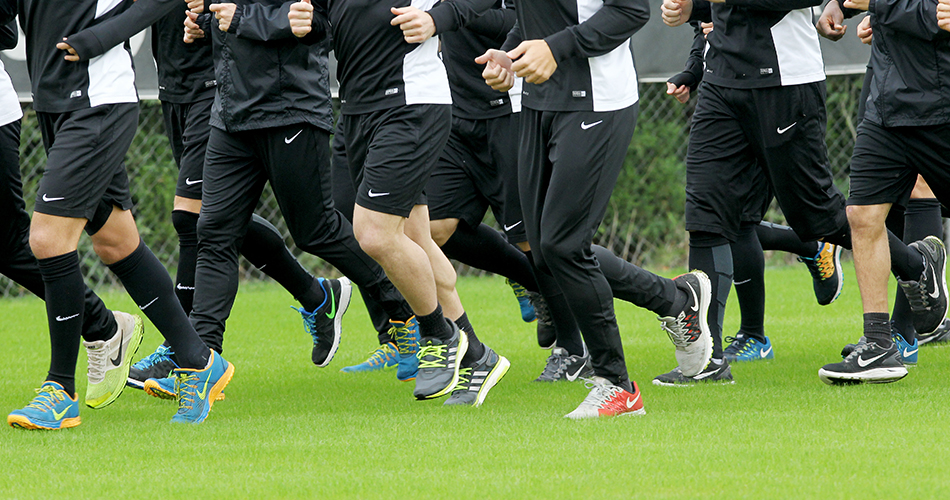









Responses